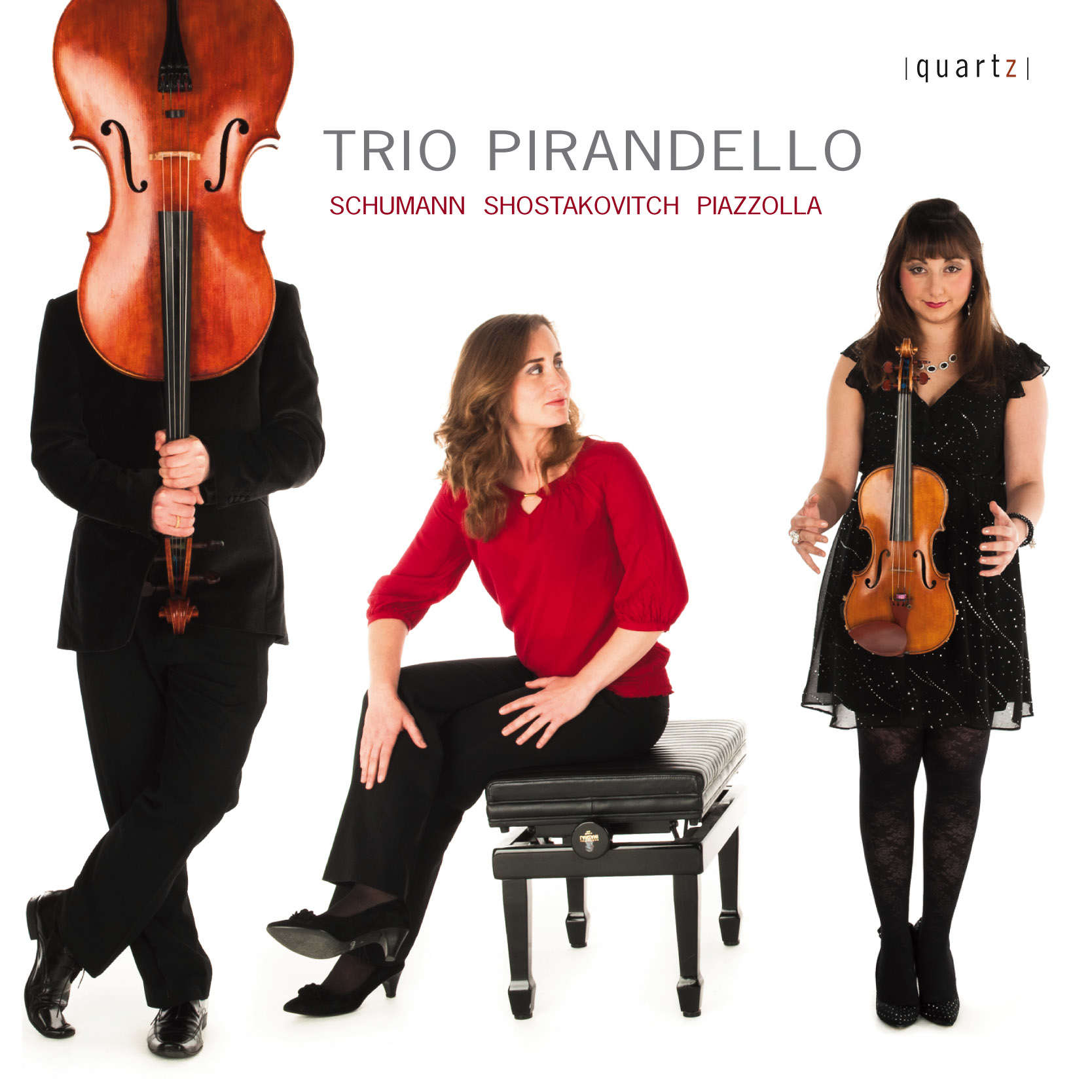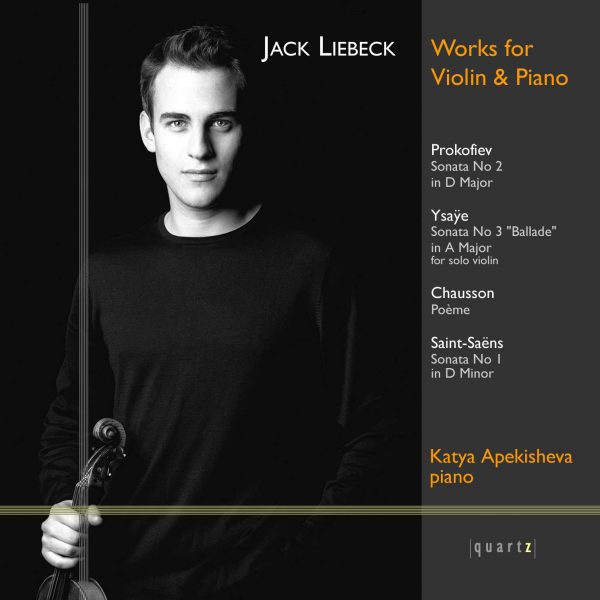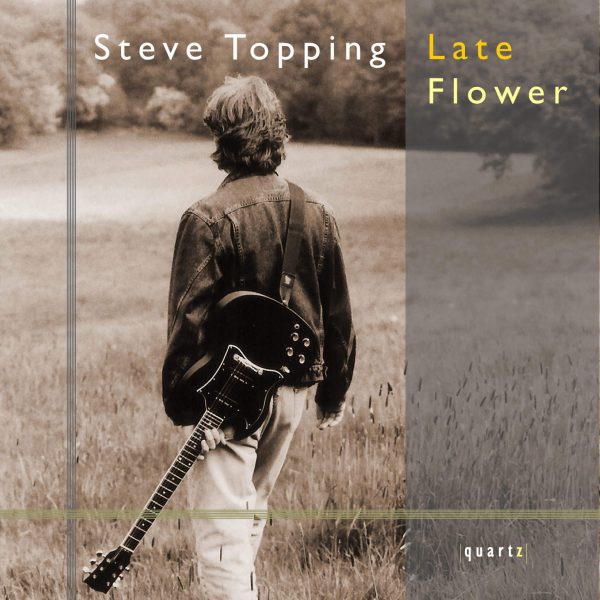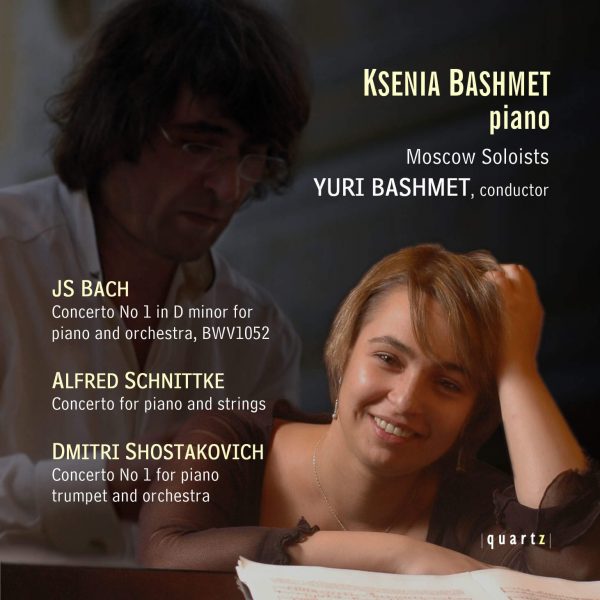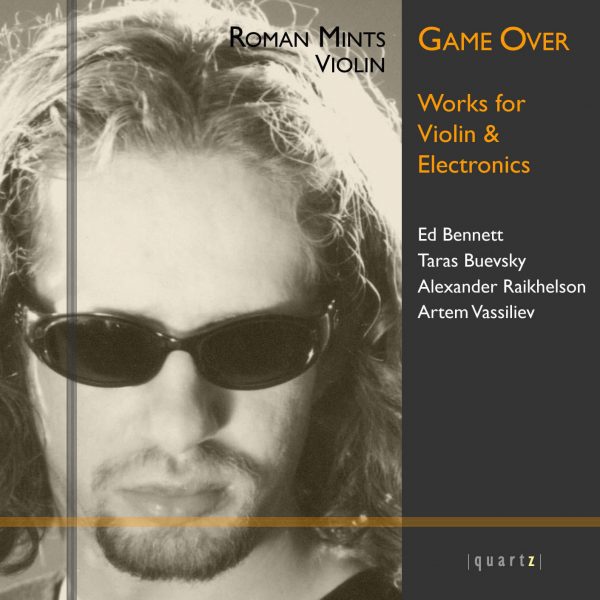Schumann | Shostakovich | Piazzolla
£5.99 – £11.99
ROBERT SCHUMANN: TRIO NO.3 IN G MINOR OP. 110
DIMITRI SHOSTAKOVICH: TRIO NO.2 IN E MINOR OP. 67
ASTOR PIAZZOLLA: OTOÑO PORTEÑO
Described by the press as an ensemble with “strong temperament and communicative sensitivity”, the Pirandello Trio is quickly establishing itself as one of the most dynamic trios of its generation. The Trio’s multicultural background – Greek, Polish, Russian, Italian, British and Swiss – is reflected both in their interpretations, full of colours and in the Trio’s repertoire from the classical canon to Argentinean tangos and beyond.
About This Recording
Apart from a few student compositions, it was not until 1842, as he approached the age of 32, that Robert Schumann began composing chamber music in earnest. Aware of Mendelssohn’s impressive accomplishments, Schumann sought to improve his own technique by studying works by Haydn, Mozart and Beethoven before producing several chamber works. Schumann particularly admired Beethoven’s approach to symphonic form, “where in rapid succession the ideas appear [ever] changing and yet are linked through an inner, spiritual bond.” By the end of the year, Schumann had written his first Piano Trio, Op.88. A second followed in 1847, and the Piano Trio No.3 in G minor, Op.110 – his last – was composed in 1851. Schumann’s physical and mental health had come under enormous strain during these years, most recently from his ill-fated appointment as music director at Düsseldorf. After an overwhelmingly warm welcome there in 1850, things had begun to turn sour. During his second season, Schumann’s ability as a conductor was, like his health, in decline; if, during rehearsals, his lack of clarity caused musicians to stop singing, Schumann tended not to notice, continuing to conduct regardless, absorbed in the music. This culminated in an argument with the deputy mayor, and an increasing sense of isolation for Schumann, who admitted to a friend that he was “very angry with certain people”.
These tensions are poured into the opening movement of Op.110, the surging opening material immediately plunging us into a restless, troubled world. Even the major-key second subject area brings only a little respite from this turbulence, with moments of tenderness just discernible as they attempt to break through the prevailing texture of urgent forward-motion.
That tenderness is allowed space to breathe in the slow movement, its beautiful, long-breathed phrases carrying an air of wistful longing; and the movement ends in a spirit of exquisite serenity. There follows a driving Scherzo, contrasted with two major-key Trio sections. Perhaps unexpectedly, after this undulating musical landscape, the finale is a rumbustious, good-humoured movement, even marked as such (“mit Humor”). Instead of wallowing in his woes, Schumann revels in comedy in what was a conscious attempt to lighten the mood. This offers us an interesting insight perhaps, into the composer’s own methods of dealing with depression – or perhaps into his sense that he ought to follow the Trio No.1’s trajectory from despair to hope, in spite of the stresses of his own situation. In any case, the finale reminds us that a composer’s biography is only partially reflected in his or her music. The happy ending of this Trio was not to be Schumann’s own, but art need not imitate life; rather, it tells its own story.
Although Dmitri Shostakovich made some of his most powerful musical statements in his symphonies, it is in his chamber music that we gain a more intimate sense of the man and his life. As Benjamin Britten described in his 1966 tribute to Shostakovich – on the occasion of the latter’s 60th birthday: … much as I admire the Symphonies and the opera, to me Shostakovich speaks most closely and most personally in his chamber music. There is a time in every artist’s life when he wishes to communicate intimate thoughts to a few friends – and I do not mean only his actual friends, but people unknown to him, who have souls sensitive to his (people from all over the world, whatever race or colour). And for this one doesn’t need the mass of full chorus or orchestra and the big halls and theatre, but small groups of performers and small halls, sometimes only private rooms.
The Piano Trio No.2 in E minor, Op.67, is indeed a personal work – on more than one level. It was begun in December 1943, and was dedicated to the composer’s friend, musicologist Ivan Sollertinsky (born 1902), who died in February 1944. Sollertinsky had seen sketches for the work not long before his death; Shostakovich went on to complete the Trio during the year, and was at the piano for its premiere on 14 November 1944, joined by two members of the Beethoven String Quartet, the violinist Dmitri Tsyganov and the cellist Sergei Shirinsky.
In addition to the dedication to Sollertinsky, Shostakovich wrote the work as a more veiled homage to his pupil Vienamin Fleishman (1913–1941), who had died in battle at Leningrad. Shostakovich lamented: “…he volunteered for the army. He was killed. He went into the People’s Volunteer Guard. They were all candidates for corpsehood…”
The final layer of personal meaning stems from Shostakovich’s tribute, in this work, to victims of the Holocaust, the news of which did not reach his homeland until the liberation of the camps had started. Shostakovich’s sympathy for those killed during World War Two, and by Stalin, was intense, as he explained: I feel eternal pain for those who were killed by Hitler, but I feel no less pain for those killed on Stalin’s orders. I suffer for everyone who was tortured, shot, or starved to death. The majority of my symphonies are tombstones. Too many of our people died and were buried in places unknown to anyone, not even their relatives. Where do you put the tombstones? Only music can do that for them. I’m willing to write a composition for each of the victims but that’s impossible, and that’s why I dedicate my music to them all.
The Piano Trio No.2 starts, unusually, with the cello playing at a higher register than the violin. This is structured as a canon, starting with the cello’s haunting harmonics, followed by the violin, then the piano in the lowest register. The use of canonic devices continues in the pacier material which follows, in which Shostakovich develops the initial theme into music of increasing energy, at times ferocious, at others possessing that sardonic humour so characteristic of his style. This dark humour continues in the frenetic Scherzo which follows.
The Largo opens with imposing, heavy piano chords. Shostakovich treats these chords as a recurrent chorale theme, repeated six times, forming the basis of a passacaglia. The canonic textures of the first movement are in evidence here, too: the violin and cello play in canon, unfolding an anguished theme which creates astringent dissonances as the two lines overlap. This movement proceeds seamlessly to the finale, in which Shostakovich uses Jewish musical idioms as an allusion to the Holocaust victims to whom he was paying tribute. Specifically, he used a scale which has the quality of quintessential Jewish melodies: the Dorian mode with an augmented fourth, as well as the jaunty rhythms associated with Jewish folk dances. Yet there is something troubling about Shostakovich’s treatment of this idiom: he deliberately turns the Jewish dance style into a danse macabre, unflinchingly drawing the listener’s attention to the horrifying realities of the Holocaust. After this searing account, the Largo’s chorale theme returns, to deeply moving effect; Shostakovich’s anger, though never absent, is translated into a heartfelt desire for the victims he is commemorating to be at peace, at last. Argentine composer Astor Piazzolla studied with Alberto Ginastera, also from Argentina, and then in Paris with the great French teacher Nadia Boulanger. With characteristic insight, it was Boulanger who recognised where Piazzolla’s real passions lay. In 1954 she urged him to focus on the tango rather than on purely classical forms, observing: “Here you have the real Piazzolla; Astor, be true to him”. In exploring and communicating the music of his country, Piazzolla was also recording and celebrating its essence, much as Bartók and Gershwin drew upon the folk and jazz styles of their countries and translated them into a classical context. Perhaps inevitably, there have been those who wish to demarcate the line between “classical” and “popular” too rigidly, who have rather dismissed Piazzolla’s music as “light”. One anecdote tells us that, in the 1950s, when Piazzolla was conducting a symphony, a member of the orchestra said, “I assume you are nothing to do with this Piazzolla who plays tangos.” For that musician, the worlds of the tango and the symphony were mutually exclusive; but not for Piazzolla, and the repertoire is the richer for it.
Written in 1969, Piazzolla’s Otoño Porteño (Buenos Aires Autumn) is a fine instance of the complexity and textural variety of his music. The piece is part of Piazzolla’s tango cycle, Estaciones Porteñas (The Four Seasons of Buenos Aires), and has been performed in a number of guises, including different versions by the composer himself. Originally composed for his quintet, with Piazzolla on bandoneón, the piece works well as a piano trio, and is full of varying textures and tempi. Piazzolla keeps us guessing throughout, shifting the music between vigorous rhythmical gestures, vibrant drama, mysterious music pulsing with anticipation, and wide-ranging, virtuosic and complex soliloquies for the instruments, each with their own distinct character. The piece ends with a flouncing, defiant throwaway gesture, combining two key elements of Piazzolla’s style: passion and humour.
© Joanna Wyld, 2014
Track Listing
-
Robert Schumann
- Trio No. 3 in G minor Op. 110 (i) Bewegt doch nicht zu rasch
- Trio No. 3 in G minor Op. 110 (ii) Ziemlich langsam
- Trio No. 3 in G minor Op. 110 (iii) Rasch
- Trio No. 3 in G minor Op. 110 (iv) Kraftig mit Humor Dmitri Shostakovich
- Trio No. 2 in E minor Op. 67 (i) Andante
- Trio No. 2 in E minor Op. 67 (ii) Allegro con brio
- Trio No. 2 in E minor Op. 67 (iii) Largo
- Trio No. 2 in E minor Op. 67 (iv) Allegretto Astor Piazzolla
- Otoño Porteño
